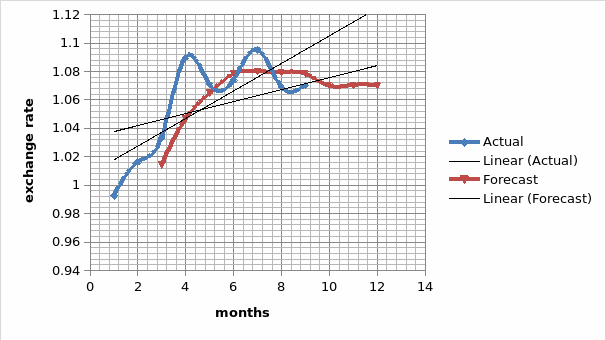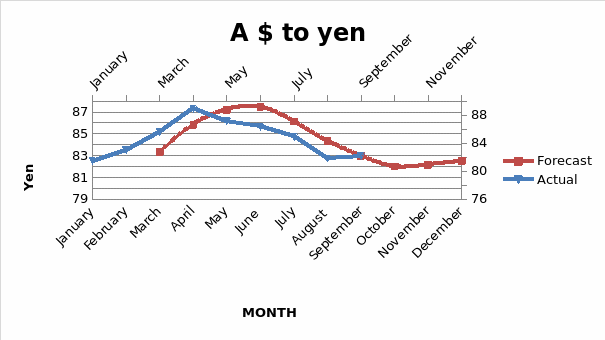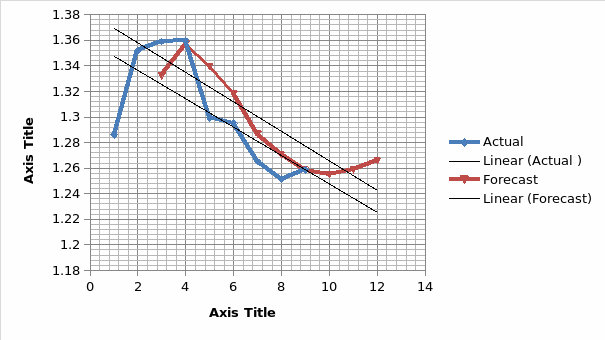Executive Summary
Demand for an Australian dollar in exchange for the Japanese yen, US dollar, and New Zealand dollar is derived from the demand for Australian goods and services. This is because Australian goods are priced in Australian dollars, thus citizens from Japan, the US, and New Zealand to pay for their Australian purchases must first exchange their currencies for Australian dollars. The forecast of these currencies indicates that an Australian dollar is appreciating against the US dollar while depreciating against the Japanese yen and New Zealand dollar. When the price of goods and services is very high it means demand for Australian goods and services in the American market is reduced.
Introduction
With the increased amount of trade among countries, the foreign exchange rate becomes very important in determining the prices of goods and services to be exchanged. A foreign exchange rate is a price at which a certain currency is exchanged for another and it is determined by inter-bank currency exchanges. Exchange rates used can be of a direct quote or indirect quote. When it is quoted per unit of the domestic currency, it is referred to as a direct quote (Goodwin, 1996; Kapil, 2011). Thus, the US $ and one Australian dollar exchange rate would be written as US$ 1.0703/ one Australian dollar. On the other hand, when the exchange rate is quoted as units of domestic currency per unit of a foreign currency, it is referred to as an indirect quote (Moles, Parrino and Kidwell, 2011; Brigham and Houston, 2008).
Data used
The historical data used in the forecast was obtained from the Reserve Bank of Australia. The actual data covered was from January 2011 to September 2011. It helped to forecast the foreign exchange rate for four months beginning September 2011 to December 2011. Moving average method of forecasting was used to determine the trend of the foreign exchange rate. However, for December the result was forecasted using the following formula to determine the rate:
Amount of appreciation (depreciation) = new dollar value of A $/ old dollar value of A$ X100
Results
Forecast of the exchange rate of one Australian dollar to US dollars
From the table below, it could be observed that the foreign exchange rate for December is 1.072 while September, October, and November are 1.078, 1.070 and 1.070 respectively. The reason for using the log of the real foreign exchange rate is that it improves the findings of the statistical testing that will be used to determine the range of foreign exchange expected in December. The excel formula has been used to calculate the mean and standard deviation. In excel one goes home then click on the formula and choose average where you will select data to calculate the mean. After that, one selects standard deviation and carries the same procedure as for mean. Then this is imported to word.
Mean = ∑xf / N and Standard deviation = √Variance
Variance =  where x is the Mean.
where x is the Mean.
(Reserve Bank of Australia 2011)
The standard deviation of the actual data is 0.0349 while the mean is 1.0569. Furthermore, by observing the monthly values of the foreign exchange rate collected over 9 months, it could be concluded that the data is normally distributed as the majority of the values lie within the standard deviation of the mean. Thus, one can use a t-test to find the range foreign exchange rate for one Australian dollar to US$ expected in December 2011. The interval for exchange rate is calculated at a 95% confidence level using the following formula:
Mean ±t X
σ/√n
1.0569 ±2.776 X
0.0349/√4 = 1.0569 ±0.0484
The exchange rate for one Australian dollar to US $ will range from 1.0085 to 1.1053. The graph below shows the forecasted and actual foreign exchange rates. It indicates an increasing trend from September 2011 to December 2011. However, there are fluctuations but on an increasing trend.

The movement in the exchange rate is due to an increase in inflation in Australia at a higher rate than in the USA and this affected demand for Australian dollars. This can be attributed to the demand for seasonal goods from the USA.
Forecast of the exchange rate of one Australian dollar for Yen
The table below shows that the Yen has a decreasing trend. The value of the one Australian dollar to Yen in December is 82.49. The standard deviation is 2.6280 and the mean is 84.5956. Using a t-test to find the interval of foreign exchange rate for one Australian dollar to Yen in December will provide the expected range of the actual result. It is calculated using the following formula at a 95% confidence level.
Mean ±t X
σ/√n
82.49 ±2.776 X
5.628/√4 = 82.49 ±2.7814
The exchange rate for one Australian dollar to Yen will range from 80.4676 to 85.2714. The excel formula has been used to calculate the mean and standard deviation. In excel one goes home then click on the formula and choose average where you will select data to calculate the mean. After that, one selects standard deviation and carries the same procedure as for mean. Then this is imported to word.
Mean = ∑xf / N and Standard deviation = √Variance
Variance = where x is the Mean.
where x is the Mean.
(Reserve Bank of Australia 2011)
The graph below shows the forecast and actual foreign exchange rates of one Australian dollar for the yen. It indicates an increasing trend from September 2011 to December 2011.

The expected movement of foreign exchange rates between the Australian dollar and yen will be due to the change of inflation rates in the two countries. Inflation affects the prices of goods and this changing demand positively or negatively.
Forecast of the exchange rate of one Australian dollar for NZ$
The excel formula has been used to calculate the mean and standard deviation. In excel one goes home then click on the formula and choose average where you will select data to calculate the mean. After that, one selects standard deviation and carries the same procedure as for mean. Then this is imported to word.
Mean = ∑xf / N and Standard deviation = √Variance
Variance = where x is the Mean.
where x is the Mean.
(Reserve Bank of Australia 2011)
The table above shows that one Australian dollar will be exchanged at 1.2660 New Zealand dollars. The standard deviation is 0.0436 with a mean of 1.3030. Thus one can use a t-test to find interval foreign exchange rate for one Australian dollar to NZ$. The expected foreign exchange rate interval for December will be calculated at a 95% confidence level using the formula below:
Mean ±t X
σ/√n
1.266 ±2.776 X
0.0436/√4 = 1.266 ±0.0605
The exchange rate for one Australian dollar to NZ$ will range from 1.2055 to 1.327.

The graph above predicts the exchange rate as having a downward trend. The expected movement of foreign exchange rates between the Australian dollar and NZ$ will be due to the change of inflation rates in the two countries. Inflation affects the prices of goods and this changing demand positively or negatively.
Conclusion
Results show that the forecasted exchange rate for one Australian dollar to US$ is on an increasing trend and it will be 1.072 in December 2011, however it may range from 1.0085 to 1.1053 at a 95% confidence level. Findings also predict that one Australian dollar will be exchanged at 82.49 yens and 95% confidence level, with a mean, which ranges from 80.4676 to 85.2714.
Reference List
Brigham, E., and Houston, J. 2008. Fundamentals of financial management. Florence: Cengage Learning.
Goodwin, P., 1996. Statistical correction of judgmental point forecasts and decisions. International Journal of Management Science, 24(6), p 551-559.
Kapil, S., 2011. Financial Management. New Delhi: Pearson Education India
Moles, P., Parrino, R., and Kidwell, D. 2011. Fundamentals of Corporate Finance. San Francinsco : John Wiley and Sons.
Reserve Bank of Australia. 2011. Exchange Rate Data.